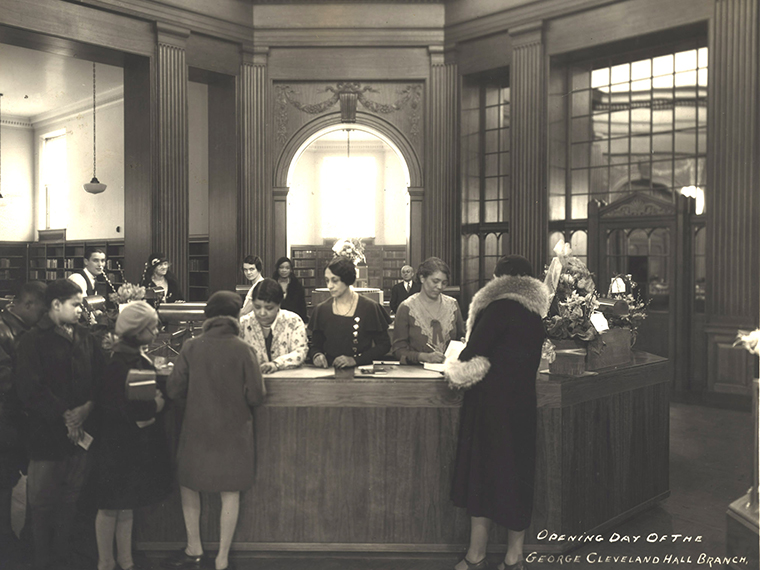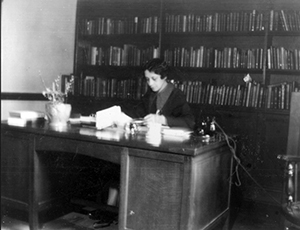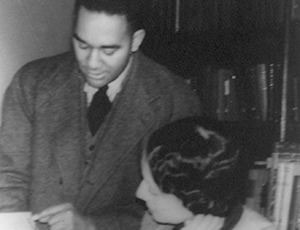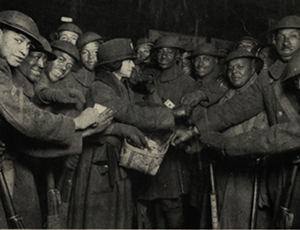In January 1932, the George Cleveland Hall Branch of Chicago Public Library opened at 48th Street and Michigan Avenue in Chicago’s Bronzeville neighborhood, during an era that would later come to be known as the Chicago Black Renaissance. The previous summer, the Chicago Defender newspaper announced that a Miss Vivian G. Harsh, with 20 years of service “and considered one of the best informed librarians in the city,” had been named “librarian-in-charge.”
Harsh, a Chicago native, graduated from Wendell Phillips High School and shortly after, in 1909, began her career with Chicago Public Library working as a junior clerk at a branch library. The Defender mentions that she worked at the Hardin Square, Mark Heights and Lincoln Center branches. By 1921, Harsh graduated from library school in Boston and later became the first African American branch head after accepting the position at the Hall Branch library.
Over time and with keen insight, Harsh collected rare books, pamphlets and materials that documented the African American experience. Funding for the “Special Negro Collection,” as it came to be called, came from grants and patron donations. Harsh also used her own money to purchase books for the collection.
In the 1930s, the collection’s reputation spread and the library became a meeting place for promising young Black writers, artists and activists. When the WPA’s Federal Writers Project was shut down, the director of the "Negro in Illinois" project donated over a hundred boxes of research materials to Harsh. Langston Hughes donated the manuscripts and galley proofs for his biography, The Big Sea. Scholars and neighborhood folk mingled at the bimonthly Book Review and Lecture Forum, which hosted such speakers as Richard Wright, Zora Neal Hurston, Gwendolyn Brooks, Alain Locke, Horace Cayton and St. Clair Drake. The collection was a success and grew into one of the largest collections of African American literature and history in the United States.
Harsh was not only a librarian but a true renaissance woman. She was a member of the YMCA, the NAACP and the Association for the Study of Negro Life and History, hosting the organization’s 20th anniversary meeting in 1935. She worked on the organization committee for a potential publication that was hoped would rival Life magazine and serve as an “organ of public opinion” in an attempt to promote racial harmony and to counteract prevalent negative stereotypes of African Americans. Sadly, the magazine never took off.
Harsh was a socialite who supported the arts and enjoyed playing whist and bridge. In 1912, she was in the running for queen of the Grand August Carnival and Negro Exposition. A May 1915 Defender article announced, "Vivian Harsh to Dance Tango," and discussed her participation in a charity variety show for Provident Hospital. In 1958, the American Economic League honored Harsh for “outstanding service and promotion of Negro life and history.”
This woman of extraordinary vision passed away in August 1960. In 1970, her Special Negro Collection was renamed the Vivian G. Harsh Research Collection of Afro-American History and Literature. Five years later, the collection was moved to the new Carter G. Woodson Regional Library. The current Harsh Collection staff is proud to carry on Harsh’s legacy and hopes to provide our patrons with the same levels of knowledge, expertise and inspiration. If you’ve used the collection or if you perhaps remember Vivian Harsh from the Hall Branch, please tell us in the comments. We’d love to hear from you!







Add a comment to: Vivian G. Harsh: Librarian of the Chicago Black Renaissance